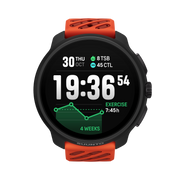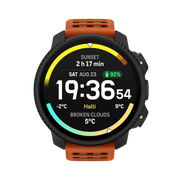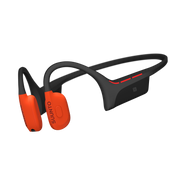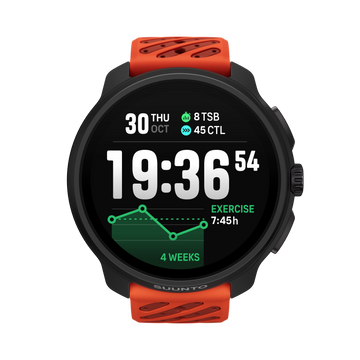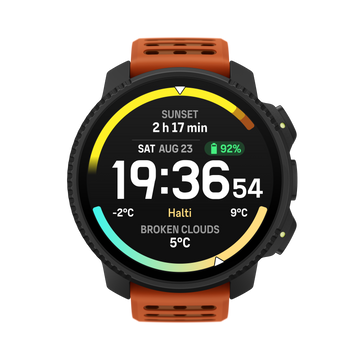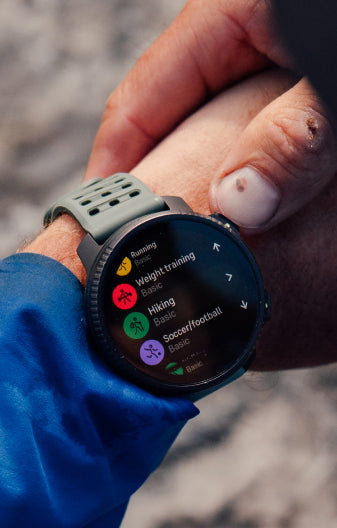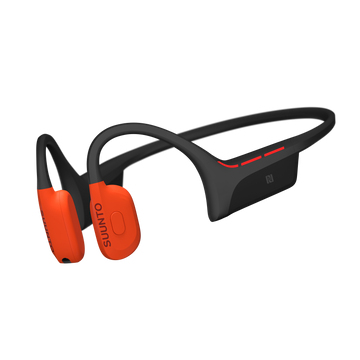

Suunto-blogg
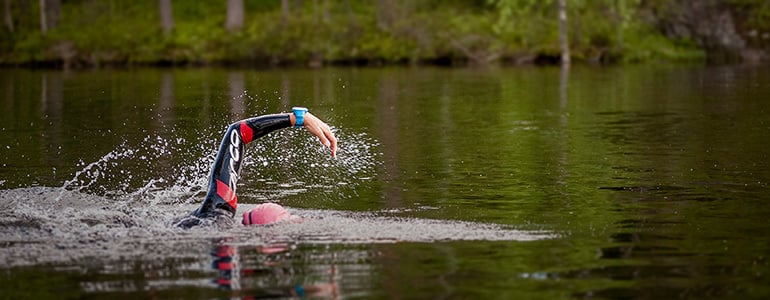
The road to Kona Ironman, Step two: rapid progress
Last week we kicked off the first instalment of our four-part series following Suunto athlete Åsa Lundström as she prepares for the coming Ironman World Championship in Kona, Hawaii. After looking at step one last week, planning, this week Åsa tells us what progress, step two, looks like as her training intensifies.
There’s one crucial sign Åsa looks for to know she’s making progress in her training for the Kona Ironman: feeling unbeatable.“They don’t come very often, but every now and then, you should get that moment, if only for a moment, that you are unbeatable,” she says. “If I don’t ever get those ‘I’m on fire today!’ moments in my training periods, then something needs changing.“I don’t do tests or anything like that to check I’m in good shape, I just look for signs, a feeling, during the quality sessions I do – it’s the feeling of being immortal, unbeatable, strong.”
Click here to read more about Åsa Lundström, the unlikely Swedish triathlete
© Orca/Gines Diaz
Having planned her training with her coach Cliff English, it’s then time to make rapid progress, to push herself towards her personal best while also ensuring she has enough recovery time.Åsa’s training progresses through three stages: the first is getting into the rhythm of hard training; the second stage involves blocks of quality and quantity sessions; and the last is a tapering period of two weeks before race day. As Åsa moves through the three stages, her coach Cliff English tracks her performance and makes adjustments to her training as required. Understanding and trust between athlete and coach is essential here.
The longer Cliff works with an athlete, the more data he accumulates, which better helps him track the athlete’s performance and recognize when changes must be made. This means both he and Åsa must be sensitive to signs they’re pushing too hard or not hard enough.
Click here to read Åsa’s 8 open water swimming tips!
“If I start having trouble sleeping, or lose my appetite that could be a sign to back off a bit,” Åsa says. “On the other hand, if I never feel exhausted after a quality session, but have an unsatisfying feeling, that could be a sign of not pushing hard enough. “I am supposed to feel tired between the sessions more or less all the time.”As her training intensifies, Åsa also works on the mental side of her training by spending time visualizing the race, the potential scenarios that could happen and how she would respond to them. “As race day gets closer, I also stop meeting people who might be sick, or even just have a minor cold,” she says. “I skip junk food and unnecessary treats and I make sure I get enough sleep every night.”
Stay tuned for third installment of our four part series about Åsa as she makes progress on the road to the Ironman World Championship in Kona.

Emelie Forsberg's 6 favorite running routes
Think you can keep up with skyrunning champion Emelie Forsberg? Or maybe – and more realistically – you just want to explore her favorite mountain landscapes? Look no further – here are Emelie’s 6 best-loved trail running routes!
All trail runners have their go-to training routes – places that feel like home every time they run them.Skyrunning champion and devoted mountain lover Emelie Forsberg has her's and three of them are in Sweden, her beautiful homeland.
Check out the six trails below for a super dose of running motivation.
Watch Emelie talk about her love of running in the mountains in the video below
Kebnekaise, Sweden
Distance: 16.09 kmTime: 04h57mAscent: 2288 mDecent: 2291 mHighest point: 2116 mWhy: I ran this trail in northern Sweden, where I used to work, with two friends. This is a tour over Touplagorni, a spectacular summit, and also Kebnekaise – Sweden’s highest mountain. It includes scrambling and some easy climbing. I love doing this kind of thing with friends!
Aiguilles des Posettes, Chamonix, France
Distance: 9.17 kmTime: 01h26mAscent: 979 mDecent: 986 mHighest point: 1998 mWhy: I really like to train on this mountain, either for a faster run in the morning or a recovery run in the afternoon. It has such a beautiful view with all the Mont Blanc massif and the Aiguilles Rouge in the front.
Click here to read more about Emelie Forsberg
High Coast, Sweden
Distance: 27.76 kmTime: 04h01mAscent: 850 mDecent: 937 mHighest point: 285 mWhy: This is where I grew up and played around. The High Coast has small hills, wild forest and beautiful nature. This is a section of the High Coast Trail.
Dent Blanche, Pennine Alps, Switzerland
Distance: 4.42 kmTime: 06h55mAscent: 836 mDecent: 785 mHighest point: 4365 mWhy: This is just an example of what I call a ‘mountain day’. I climb and run a new, higher mountain that is technical and slower to summit. Dent Blanche has a climbing rating of AD; it’s fairly difficulty, requires belayed climbing and is exposed. I do this kind of day four to six times a month and I really love this kind of training!
Glen Coe, Highlands, Scotland
Distance: 50.62 kmTime: 07h44mAscent: 3954 mDecent: 3943 mHighest point: 1146 mWhy: This is route is from the seriously super cool Glen Coe Skyline race. For sure, I need to do this race again. So cool to race in this kind of raw environment where I really like to train. It’s scrambling, wild ridges, difficult downhill’s, but also fast trails to let the legs going fast! To share it during a race was awesome.
Jämtlands Mountains, Sweden
Distance: 35.70 kmTime: 05h21mAscent: 604 mDecent: 893 mHighest point: 1120 mWhy: This was a typical day out for me when I was working in the Swedish mountains. It has beautiful flat trails that means you can run for a long time! I was often running in between huts with only a small backpack.
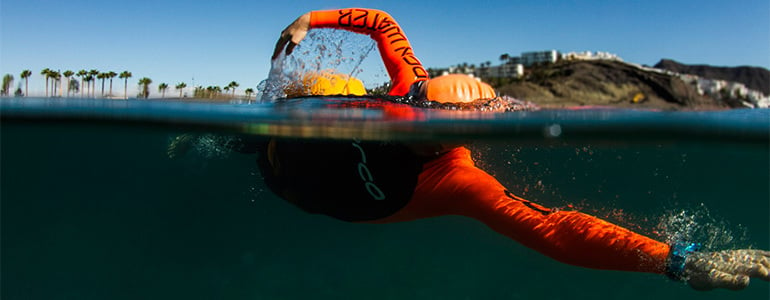
The road to Kona Ironman, Step One: Planning for Success
What does it take to train for the Ironman World Championship in Kona, Hawaii? Follow our four-part series about Suunto athlete Åsa Lundström as she prepares and find out!
For Swedish triathlete Åsa Lundström the next few weeks are everything.
Over the last month, the 30-year-old medical student and professional athlete has been preparing for the approaching Ironman World Championship in Kona, Hawaii on October 10th, 2015.
It’s the legendary Ironman that every triathlete dreams of competing in. That dream is about to become a reality for Åsa.
“Every sport has tales to tell of battles on the race course,” she says. “And with Ironman, we all hear stories of the legendary clashes of the triathlon titans at Kona.
“The best part is that we now have the opportunity to become one of those stories.”
Click here to read more about Åsa, the unlikely Swedish triathlete
Like all big projects, Åsa's road to Kona begins with the most important step: careful planning. She works closely with her professional triathlete coach, Cliff English, for this. When to intensify, where to train and when to go to Hawaii have all been planned well in advance.
Cliff updates Åsa’s training schedule week-by-week, always trying to find the right balance between the intensity and volume of her training and ensuring she gets enough recovery time.
“I’m constantly monitoring her sessions, looking at objective measurements, such as pace and power, as well as her subjective feedback on each session and on other factors including sleep quality, muscle soreness and freshness,” Cliff says.
During a normal training week, Åsa puts in between 20 and 25 hours. For Kona, that jumps to 35 hours every week. Her life becomes structured around training. In one week, she swims five or six times, cycles four or five times, runs five to six times and does strength and core training three times.
“Åsa typically trains two to three times per day,” Cliff says. “Some of the sessions are separate with a morning session then a midday session and typically a lighter active recovery session later in the day.
“I tend to prescribe one key session per day, however I also include combo sessions that include bike and run that are typically executed at race efforts.”
All this training might sound austere, like Åsa has no life, but she enjoys the process.
“When I have a big goal to work towards, it feels natural to focus on that, and to make choices adjusted to it,” Åsa says. “I don’t believe being disciplined means life cannot be fun at the same time.”
To keep things fun and to plan in a short term training goal, Åsa recently competed in the Tjörn Triathlon in Sweden and won the women’s division.
“It was a great boost,” she says, “and gave me proof that my training is going in the right direction.”
That’s important because she says it’s not always easy to tell if her build up is going well.
“When you are in a big training period, you feel tired and worn, and it’s hard to tell sometimes,” she explains. “However, when you feel tired, and you somehow manage to make the body do what you ask, then this is a good sign, especially if you were able to push yourself to a required pace or effort you didn’t think you could do.”
Åsa recently travelled to Fuerteventura in the Canary Islands to begin her final preparations. The warmer conditions are more similar to Hawaii than in Sweden, making it a good training ground.
Check out the second step, progress, of our four part series about Åsa as she continues on the road to the Ironman World Championship in Kona.

Kilian Jornet's top 5 training routes
How do you measure up to the world's best trail runner? Why not run one of his favorite training routes and find out!
Kilian has lived and trained in places considered dream destinations by trail runners everywhere. Alaska, Norway, the Rocky Mountains, the Alps, Patagonia – whereever there are impressive mountains Kilian has probably smashed the local trails there. Who better to ask about the best trail running routes in the world?
Whether you want to try to match his stats or to literally follow in his footsteps, Kilian's top five training routes will be a source of inspiration.
Kilian ascending Mont Blanc. © Jordi Saragossa
Ersfjord Traverse, Kvaloya, Norway
Distance: 18.09 kmTime: 04h49mAscent: 2758 mDecent: 2751 mHighest point: 1093 mWhy: "It’s a combination of scrambling and running. The landscapes are awesome during the entire run which follows narrow ridges above the fjord. It’s a technical run with a lot of elevation gain," Kilian says.
Aiguille de l’M, Chamonix, France
Distance: 17.10 kmTime: 03h39mAscent: 1782 mDecent: 1744 mHighest point: 2844 mWhy: "Great running and some climbing to Aiguille de l’M, with great views all over the Mont Blanc massif," Kilian says.
Mont Blanc, Chamonix, France
Distance: 24.78 kmTime: 05h57mAscent: 3808 mDecent: 2461 mHighest point: 4815 mWhy: "Up to Mont Blanc, either the direction in the map below or via Gouter Hut. It’s a long elevation run with some altitude and amazing views of the Alps from summit."
Pic Carlit, Font-Romeu-Odeillo-Via, French Pyrenees
Distance: 21.30 kmTime: 03h12mAscent: 861 mDecent: 864 mHighest point: 2633 mWhy: "Running from Font-Romeu-Odeillo-Via up to Pic Carlit and Lac de Bouillouses you can see the beauty and the wilderness of the Pyrenees."
Kilian striding out in the Pyrenees. © Monica Dalmasso
Grand Teton, Rocky Mountains, USA
Distance: 19.27 kmTime: 02h54mAscent: 2264 mDecent: 2260 mHighest point: 4197 mWhy: "The Teton Range in the Rocky Mountains is a wonderful area for running with wild animals, and technical rocky trails," Kilian says.
Relaxing in the wilds of the Teton Range. © Montaz Rosset Visuals

The stage race across the Alps in 8 pictures
The GORE-TEX® TRANSALPINE-RUN is not for the faint hearted. Reaching the finish line of the eight-stage race across the Alps will take every scrap of your being. Get a taste of this epic adventure with the eight images below!
The 11th edition of the GORE-TEX® TRANSALPINE-RUN finished last week and Suunto was the official time sponsor. The eight-stage, 268 km race across the Alps from Germany to Italy is a gruelling test of endurance. Because it crosses exposed and sometimes isolated alpine terrain, competitors must race in two man teams for their own safety. Trail runner and ski mountaineer Philipp Reiter, along with teammate Iker Karrera, won the race in 2012. This year, due to an injury, the 24-year-old German could not compete so instead he photographed each stage of the race.“Crossing the Alps from north to south is a kind of a dream,” he says. “For eight days you’re in your own world.”
Click here to see this year's results.
Stage one: Oberstdorf, Germany to Lech, Austria
Distance: 34.60 kmVertical ascent: 2083 mVertical descent: 1469 m
All good times and smiles on day one. © Philipp Reiter
“This year the first stages were really hot, 36° C, so a lot of people became dehydrated and some collapsed,” Philipp says. “The race medical team had a lot of things to do.”
Stage two: Lech, Austria to St. Anton am Arlberg
Distance: 24.70 kmVertical ascent: 1899 mVertical descent: 2040 m
© Philipp Reiter
“People are used to running, but not everyday for that long,” Philipp says. “You have to make sure your body is able to deal with the distance and vertical gain for eight days.”
Stage three: St. Anton am Arlberg, Austria to Landeck, Austria
Distance: 39.60 kmVertical ascent: 2658 mVertical descent: 3133 m
© Philipp Reiter
“In my experience, stage three is really tough because you are feeling exhausted from the first two days, but know there’s another five days ahead of you,” Philipp says.
Stage four: Landeck, Austria to Samnaun, Switzerland
Distance: 45.70 kmVertical ascent: 2861 mVertical descent: 1829 m
© Philipp Reiter
“It’s funny, because each day when I get up in the morning I don’t know how I can complete the stage because I’m so tired and sore, but once you start, you just keep going and it works,” Philipp says. “It’s interesting to see how much the body can achieve.”
Stage five: Samnaun, Switzerland – vertical sprint
Distance: 06.23 kmVertical ascent: 731 mVertical descent: 60 m
Landie Greyling (above) and husband Christiaan Greyling won second in the mixed category this year. © Philipp Reiter
Stage five is the so-called “rest day” of the Transalpine Run. However, to keep the muscles warm, it includes a 6 km uphill sprint!
“Sometimes you run in the snow and it’s freezing cold,” Philipp says. “Then the next day it might be 36° C. The weather can change quickly. Everyone has to carry mandatory safety gear.”
Stage six: Samnaun, Switzerland to Scuol, Switzerland
Distance: 37.10 kmVertical ascent: 2064 mVertical descent: 2698 m
© Philipp Reiter
“It’s crazy – competitors spend their holidays crossing the Alps,” Philipp says. “These guys pay to run over the mountains and are out for about 10 hours a day and have no real recovery time.”
Stage 7: Scuol, Switzerland to St. Valentin, Austria
Distance: 37.80 kmVertical ascent: 1633 mVertical descent: 1369 m
© Philipp Reiter
“To train for this race you have to keep training everyday for a longer period,” Philipp says. “It’s not just physical fitness but also mental preparation.”
Stage eight: St. Valentin, Austria to Sulden, Italy
Distance: 42.60 kmVertical ascent: 2381 mVertical descent: 1934 m
© Philipp Reiter
“There is a party at the end, but people are so tired and after two beers they’re drunk,” Philipp says. “What’s unique, is only finishers get a finisher’s t-shirt – the rest get destroyed.”
Main image: © Philipp Reiter

Running with a common goal
Many times adventure or endurance sports can be solitary pursuits. When we share our experiences and challenges with others, we are strengthened. As a new edition to our efforts to help build connections, we will be sharing stories from inspiring groups around the world whose love for sport and adventure not only build camaraderie amongst themselves, but also serve to invigorate and motivate all of us together.
In Suunto’s home country of Finland, trail running has moved from niche to mainstream with incredible speed. Races that had only a handful of runners two years ago, now sell-out to their capacity in hours. Located all over the country, trail races are a natural extension to the almost inherent connection Finns have with nature, from orienteering to cross-country skiing. Vast expanses of forested wilderness and rolling fjells provide countless opportunities to explore.
The Nuuksio Classic trail marathon is one of the most popular races on the calendar, happening the first weekend in September. It is held on the beautiful and varied trails and grey rock of the Nuuksio National Park just outside the capital, Helsinki.
We joined a training run in Nuuksio as runners from all walks of life and levels of experience were preparing for the marathon and getting to know the trail. For many of these runners, race day is the opportunity to challenge oneself and celebrate accomplishments, but the real transformative value of running and community come through the daily training, the scars, the group runs, the early morning miles and getting lost in the forest on a new (or old) trail.
As Ali Leivo, an avid trail runner and community stalwart, says, “while the Finnish trail running community is small, it is like a family. I could shoot off to anywhere in the country and someone would welcome me, not only on their home trails, but into their homes as well.” This community often congregates, and reunites in some of the most iconic national landscapes, prepared for the challenges ahead and sharing their collective energy with one another.
Community encourages us to explore, both our wondrous natural world and within ourselves. As we embrace new connections, our energy combines and propels us forward, and when you are running in the wild it’s always nice to know someone’s got your back.
We’ll return soon with our next instalment of community events. Stay tuned!
